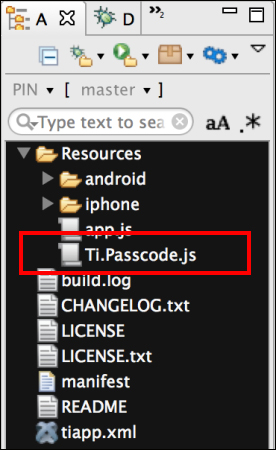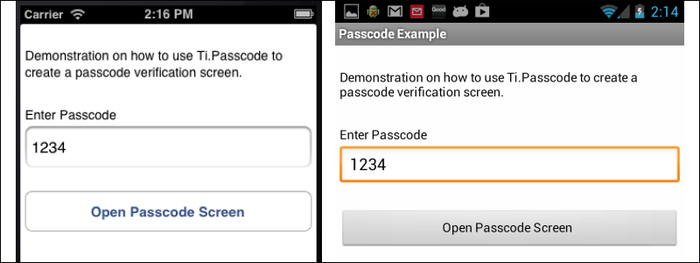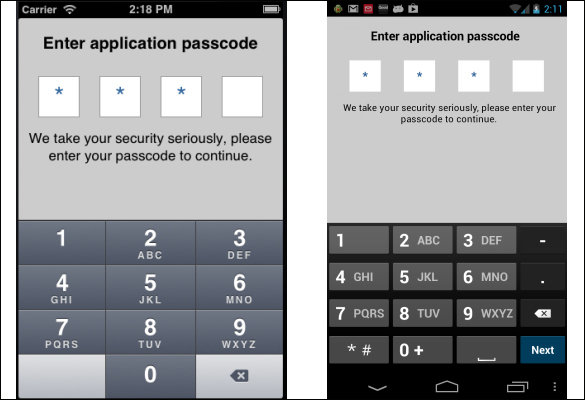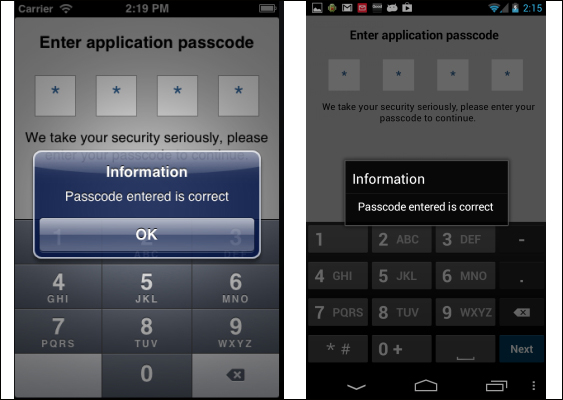Password and passcode screens are common verification instruments for enterprise apps. These screens provide interaction patterns that help solve both authentication and confirmation scenarios.
This recipe demonstrates how to implement a cross-platform passcode screen similar to those seen on iOS and in the Android networking screens.
This recipe uses the Ti.Passcode CommonJS module to implement a cross-platform passcode screen. This module and other code assets can be downloaded from the source provided by the book, or individually through the links provided in the See also section at the end of this recipe. Installing this module in your project is straightforward. Simply copy the Ti.Passcode.js file into the Resources folder of your project as shown in the following screenshot:

Once you have added the Ti.Passcode.js file to your project, you need to create your application namespaces in the app.js file and use require to import the module into your code as the following code demonstrates:
//Create our application namespace
var my = {
mod : require('Ti.Passcode')
};This recipe uses Ti.UI.Windows to present information to the user. The code used to create the first Ti.UI.Window is discussed in this section. This section details how to launch the Ti.Passcode module and provides a code to have it verified.

Now perform the following steps:
- First, a
Ti.UI.Windowis created to attach all UI elements.var win = Ti.UI.createWindow({ backgroundColor: '#fff', title: 'Passcode Example', layout:'vertical',fullscreen:false, exitOnClose:true }); - Next the
txtPasscode Ti.UI.TextFieldis added to theTi.UI.Window. This control is used to collect the passcode that theTi.Passcodemodule will verify against.var txtPasscode = Ti.UI.createTextField({ value:'1234',hintText:'Enter Passcode', height:45, left:5, right:5, borderStyle:Ti.UI.INPUT_BORDERSTYLE_ROUNDED }); win.add(txtPasscode); - Finally the
bntRunPasscode Ti.UI.Buttonis added to theTi.UI.Window. This button will be used later in the recipe to launch the passcode screen.var btnRunPasscode = Ti.UI.createButton({ title:'Open Passcode Screen', top:25, height:45, left:5, right:5 }); win.add(btnRunPasscode);
The second Ti.UI.Window in this recipe is created by the Ti.Passcode module. This Ti.UI.Window is responsible for the presentation and verification of the application passcode. This section describes how to configure, create, and confirm your app passcode using this module's display element shown in the following screenshot:

The passcode verification screen is launched when the user taps the btnRunPasscode Ti.UI.Button and triggers the click event to be fired. The following code snippet discusses the actions performed after the click event is fired:
btnRunPasscode.addEventListener('click',function(x){- The first code block in the
clickevent of thebtnRunPasscodebutton is to create our configuration and other variables. Theoptionsobject contains all of the settings needed to configure theTi.Passcodewindow.var codeWindow = null, options = { - The
windowconfiguration element allows for all of the standardTi.UI.Windowproperties to be used. The following snippet shows how to set thebackgroudnColorandnavBarHiddenproperties on the passcode window.window:{ backgroundColor:'#ccc', navBarHidden:true }, - The
viewconfiguration element allows for the configuration of a majority of the components displayed in theTi.Passcodewindow. The following snippet demonstrates how to set thepasscodetitle property and code for displaying the error message:view:{ title:'Enter application passcode', errorColor:'yellow' } }; - Next the
onCompletedcallback function is defined. This function will be used as the callback method provided to theTi.Passcodemodule. The passcode verification results will be provided as a dictionary to thedinput parameters.function onCompleted(d){ - The
dargument is an object with the verification results. Thed.successproperty provides an indicator if the entered passcode matches the passcode provided on launch. The following code snippet alerts the user if they have entered the correct passcode or if they need to try the process again.if(d.success){ alert('Passcode entered is correct'), codeWindow.close(); }else{ Alert('Invalid passcode, please try again'), } }; - The next step in this section of the recipe is to create a new instance of the passcode module. The following snippet demonstrates how to do this:
var passcode = new my.mod();
- The
createWindowmethod is then called on the new passcode instance. This method provides the passcode to verify from thetxtPasscodecontrol, and also provides the callback and options objects created earlier. This method then returns aTi.UI.Window. Once the passcode has been entered, the callback methodonCompletedwill send the verification results.var codeWindow = passcode.createWindow(txtPasscode.value, onCompleted,options);
- The
Ti.UI.Windowreturned by thecreateWindowmethod is then opened with a modal flag. The passcodeTi.UI.Windowwill remain open until closed by theonCompletedcallback method as discussed earlier.codeWindow.open({modal:true}); });
The following screenshots illustrate how this section of the code looks on the device after the user has successfully entered his/her passcode.

- This recipe uses the
Ti.PasscodeCommonJS module. To read the documentation and to learn more about this project, please visit https://github.com/benbahrenburg/Ti.Passcode.
